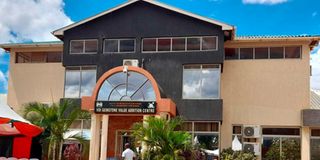‘UhuRuto’ mega projects now turning into white elephants

A Sh60 million Voi Gemstone Centre that has lied idle for over four years since it's completion in 2018. Leaders and miners in Taita Taveta County are calling for the operationalisation of the facility.
With just over a month to the August 9 General Election, the Jubilee administration is yet to fulfil a number of its 2017 campaign pledges made to residents of Taita Taveta County.
During their re-election campaign, President Uhuru Kenyatta and his deputy William Ruto wooed voters with promises of launching several mega projects.
They included the Sh35 billion Mzima Two project that seeks to provide water to over 1.5 million people, the Sh380 Bachuma Livestock Export Processing Zone, Sh300 million Ikanga airstrip and the Sh60 million Voi Gemstone Value Addition Centre. Some of them remain plans on paper while others have stalled five years after they were launched.
The Voi Gemstone Value Addition Centre is yet to be opened for public use although it was completed in 2018.
Centre manager Edward Omitto said plans to launch operations are at an advanced stage, and that the government has gazetted a committee that will oversee operations while traders had been allocated space at the premises.
The government projects to collect over Sh3 billion annually from the facility that is expected to prevent the export of unprocessed gemstones.
The Mzima Two pipeline was expected to draw over 100,000 cubic metres of water per day from Mzima Springs and would serve Taita Taveta, Kwale, Kilifi, Tana River and Mombasa counties. It would complement the existing pipeline that supplies 40,000 cubic metres of water daily and serves over five million people in the five counties.
In 2021, the Coast Water Works Development Agency indicated that the government had sent a funding proposal to Exim Bank of China, which was yet to be approved, to start the project. Speaking in Wundanyi, Taita Taveta Woman Representative Lydia Haika said the government had neglected some of the projects, citing Mzima Two.
Delays to complete the projects
The MP blamed the delays to complete the projects on the “Handshake” political pact between President Kenyatta and Azimio la Umoja One Kenya Coalition Party presidential candidate Raila Odinga.
“I request the next government to ensure that we get all our projects implemented. We’re suffering because of lack of water and this project would have saved us,” she said while drumming up support for DP Ruto’s Kenya Kwanza Alliance.
At the Ikanga airstrip, whose upgrade stalled in 2016, Kenya Airports Authority had planned to compensate over 45 landowners to resume works but the government is yet to allocate funds for completion of the project, which is 98 per cent complete.
It involves extension of the runway to 1.6 kilometres to enable bigger aircraft to take off and land, construction of shades, an airstrip terminal, a waiting lounge, a security booth and a perimeter wall. The airstrip is expected to boost tourism.
The Bachuma Livestock Export Processing Zone in Voi Sub-county has also stalled. The project was launched in 2015 and is among the President’s flagship projects under the Big Four Agenda.
It was to be completed by 2020 to boost beef export by facilitating access to overseas markets, but has been marred by delays that have led to numerous extensions of deadlines by the contractor.
Phase I is 95 per cent complete while the second is at 65 per cent. In 2020 the government terminated its contract with Techniques Supplies Limited due to the delays.
Early this year, the government announced setting aside Sh100 million to complete the project.
Livestock and Fisheries Chief Administrative Secretary Lawrence Omuhaka had said that the funds would be made available in this financial year.
“The project had been handed over to the Kenya Defence Forces but they were unable to oversee its implementation,” he said.
Once complete, the facility will process up to 100,000 cattle and will boost livestock exports to lucrative overseas markets in the Middle East where there is a high demand for meat from East Africa.





